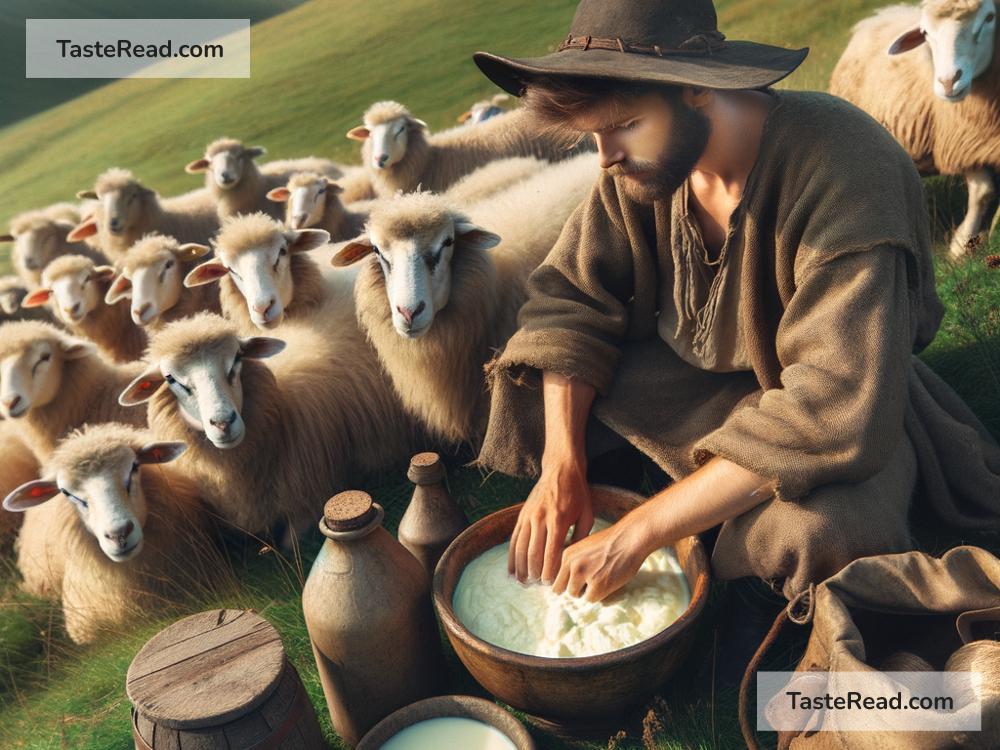The Mythical Invention of Cheese: A Shepherd’s Tale
Cheese is one of the world’s most loved foods, enjoyed across cultures and spanning thousands of years of history. But have you ever stopped to wonder: how was cheese invented? This question has a fascinating story behind it that dates back to ancient times. According to legend, cheese owes its creation to shepherds who stumbled upon its discovery by pure accident. Let’s explore the mythical invention of cheese and how this unexpected culinary breakthrough became a staple in diets around the globe.
Milk and the Shepherd’s Journey
The story begins thousands of years ago, when shepherds first domesticated animals like sheep, goats, and cows. These animals provided milk, an essential source of nourishment for early people. Shepherds would roam long distances, leading their animals in search of fresh grasslands and water. To carry their milk, they needed something portable and sturdy. Legend has it that shepherds stored milk in pouches made from the stomachs of animals. This was a common practice because animal stomachs were naturally strong and could hold liquids without leaking.
Unbeknownst to these shepherds, however, the animal stomach lining contained an enzyme called rennet. This enzyme plays a key role in the cheesemaking process. Over time, the milk inside the pouch would interact with the rennet, causing a chemical reaction that transformed the milk into curds and whey.
The Accidental Discovery
Imagine a shepherd on a hot day, traveling across the rugged countryside. He reaches for his pouch to drink some refreshing milk, only to find that something strange has happened. Instead of the smooth liquid he expected, the milk inside his pouch had separated into solid clumps (curds) and a watery liquid (whey). Intrigued rather than discouraged, the shepherd tastes the curds and discovers they are not only edible but also delicious!
This accidental discovery marked the first step toward the invention of cheese. Shepherds, curious about this strange transformation, continued to experiment with milk storage and eventually learned to harness the process of curdling to create different types of cheese.
How Nature Played a Role
The invention of cheese didn’t just depend on rennet; other factors from nature played a role as well. The temperature, humidity, and bacteria in the environment all influenced the texture and flavor of the cheese. Ancient shepherds likely noticed that milk stored under certain conditions produced better curds than others. Over time, they began to understand that small differences in the environment could change the taste and quality of the cheese. This led to the development of distinct types of cheese based on local climate and available resources.
Animals themselves also influenced the variety of cheese. For example, milk from goats, sheep, or cows produced cheese with unique flavors and textures. Regions where goats were more common might have developed soft cheeses, while areas with an abundance of cows leaned toward harder cheeses. Shepherds eventually mastered these differences, and cheesemaking evolved into an art form.
Cheese Spreads Around the World
The invention of cheese didn’t stay confined to those ancient shepherds for long. As civilizations grew and people traveled and traded, so did their food. Cheese quickly spread across Europe, the Middle East, and Asia, becoming a dietary staple. By the time of Ancient Egypt, Greece, and Rome, people were already making cheese with greater skill and consistency.
In Greece, cheese was so important that it appears in mythology. The Greeks believed cheese was a gift from the gods, particularly Aristaeus, who taught mortals how to turn milk into cheese. Romans brought cheese to new heights, creating techniques that led to variety and preservation, which allowed them to transport cheese across long distances. They introduced cheesemaking to the lands they conquered, laying the foundation for Europe’s rich cheesemaking traditions today.
Cheesemaking Today
While the shepherds of long ago relied on chance and curiosity to create cheese, we now have a much deeper understanding of the science behind it. Today, cheesemakers use sophisticated techniques and tools to produce hundreds of varieties of cheese, from creamy mozzarella to aged cheddar. Despite this progress, the basic principles of cheesemaking remain the same as they were in ancient times: milk, rennet, and the natural environment.
Cheese continues to be appreciated for its versatility and rich history. It’s a key ingredient in countless dishes, from pizza to fondue, and is enjoyed on its own as a snack or paired with wine or fruit. Every country has its unique spin on cheesemaking, making it one of the most diverse foods on the planet.
Conclusion: A Happy Accident with Lasting Impact
The mythical invention of cheese by shepherds reminds us that some of the best discoveries happen by accident. What started as a simple mistake in ancient times led to one of humanity’s most beloved foods. These shepherds likely had no idea that their curdled milk would one day turn into a global phenomenon, enjoyed by millions of people every day.
So, the next time you bite into a slice of pizza or savor a piece of creamy brie, take a moment to remember the humble shepherds who, guided by curiosity and nature, gifted us with this delicious food. Cheese may have started as an accident in the wild, but it has brought us centuries of joy and flavor.


